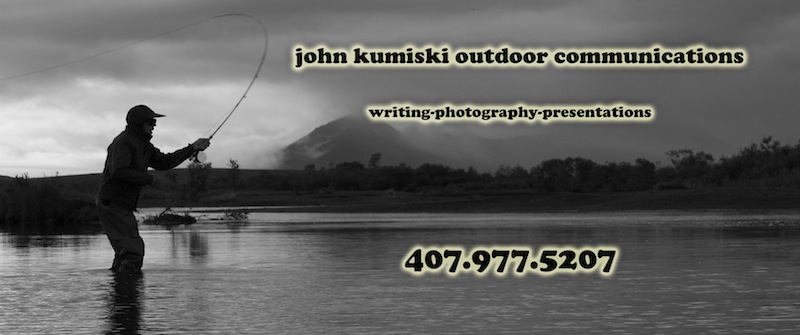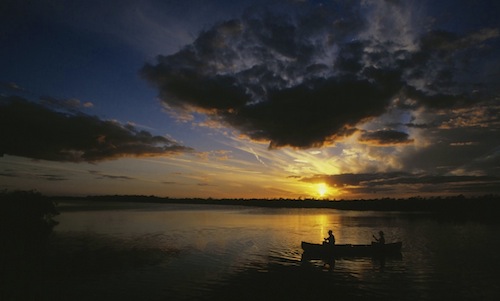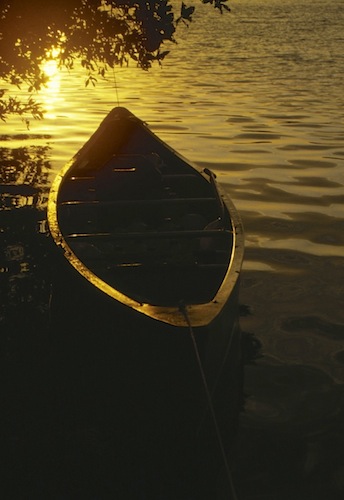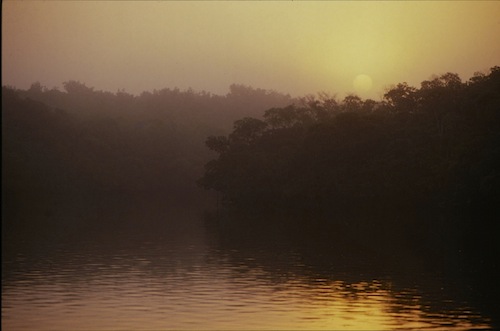First Trip
My first trip to the everglades was a five-day canoe trip in March 1980. A friend from Massachusetts and I drove down with the boat and some camping gear for spring break. We dropped the Old Town into Coot Bay Pond and paddled to Cape Sable, then back to Flamingo. I think we saw four other boats during that time. It was a wild, unforgiving place- hot, no fresh water, bad bugs, hellish sun. There was no one around. If you had a problem you were on your own.
I loved it.
The birds were incredible. We caught a chunky fish with a big spot near its tail. We didn’t know what it was but we ate it. It was good.
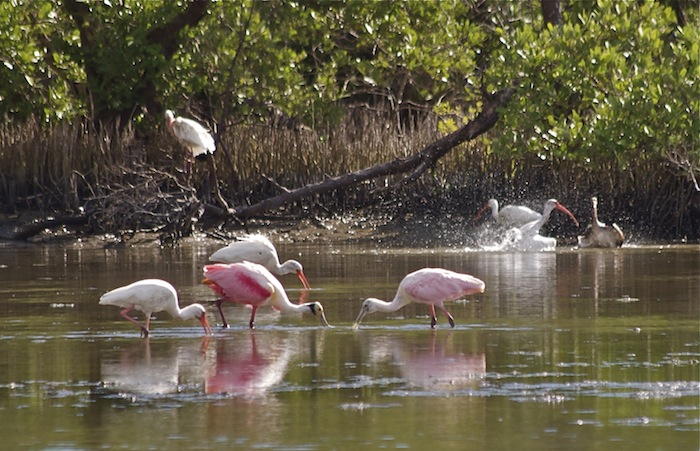
We left the Joe River chickee at dawn one morning. We had to catch the last of the tide to the Gulf. We got to the mouth of Little Shark River just after sunrise, at almost dead low tide. Tarpon rolled everywhere. I’d never seen one before. Each fish we saw just added to the magic and excitement of the moment.
Three hit my Rebel. Of course, all jumped right off. It was a watershed moment for me in my fishing career, simply a spectacular, unexpected, amazing event.
In spite of all the fish we had to keep going. There were many miles left.
When we got to middle Cape Sable there was a small aluminum skiff beached there. The lone fisherman walked the beach, casting. Not much was said at first.
The moon must have been at the right phase because the current ran so hard off the point that a whirlpool had formed. You didn’t need to be Joe Brooks to know that fish were there. I cast a jig over and over but did not get a bite.
The fisherman yelled over at me. “Get a shrimp out of the bait bucket.” I did as I was told, put it on the hook of the jig. The jig no sooner hit the water than I had a fish, a crevalle. I started casting again. Nothing.
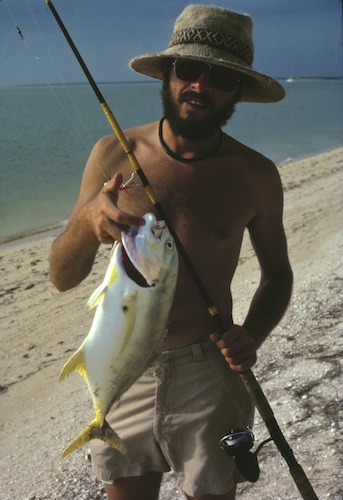
The fisherman yelled, “Get another shrimp!” I followed instructions again. The jig-shrimp combination hit the water- WHAM. This time it was a long, silver fish I later found out was called a ladyfish.
By now I was getting the idea that some meat on the hook was a good thing. I killed the long silver fish and filleted it, then cut a fillet into strips. A strip was added to the jig. It worked well.
Another Visit
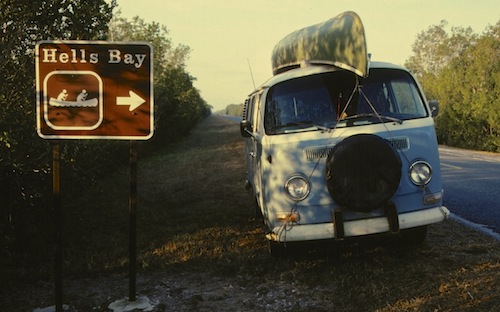

A few years later Susan and I took a six-day trip. There were six of us on this one, two adult males, three adult females, and a 10 year old boy. It was not a strong party. They were not into early starts.
We took the same route as my first trip. We reached the Gulf at noon. No tarpon greeted us. The Gulf was covered in whitecaps. We had miles to paddle, right into the wind.
It was brutal. No way we would make Cape Sable.
A wall of mangroves lined the shoreline as far as we could see. There was no place to camp. We had to keep going.
We couldn’t stop to rest. We would lose all the distance we had so painfully gained. The shoreline mangroves barely crawled past as we struggled south.
Late in the afternoon we came upon a creek mouth with a tiny piece of beach. We hit the shore. The women got out of the boats and collapsed on the sand.
Tim and I set up camp, made supper. The women got up to eat, then crawled into the tents.
Everyone was able to paddle the next day, and the rest of the trip went off perfectly.
I’ve hiked in the Appalachians, the Rockies, the Alps, and the Andes. I’ve taken canoe trips in ten different states. I work as a fishing guide in Florida and in Alaska. That was the single toughest day I’ve ever spent outdoors, anywhere, doing anything.

Merry Christmas!
Ken Shannon and I had made a couple trips out of Flamingo. During one of these trips a hard cold front came through. We were cold, not expecting temperatures in the 30s. Socks don’t make good mittens, but they are better than nothing.
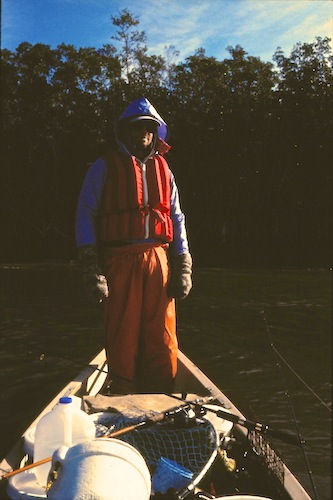
The mangrove crabs were cold, too.
Ordinarily these little crabs are almost impossible to catch. While they were cold, though, we collected a quart. They made superior bait for redfish, black drum, and sheepshead. We ate real well for several days.
We were at the Oyster Bay chickee on Christmas eve. We had hoop nets and had caught a few blue crabs. I used the crabs and a couple seatrout to make a wonderfully delicious chowder. After eating our fill we were debating what to do with the leftovers when the sound of a small outboard reached our ears.
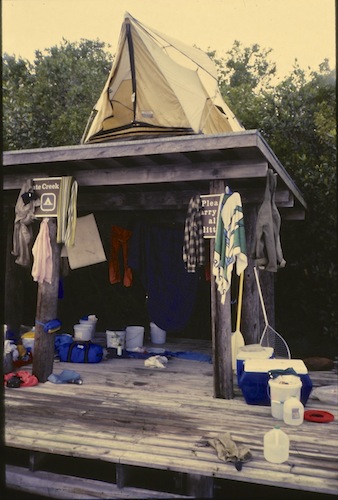
We were surprised. It was near dark.
The sound got louder. It was obviously approaching us. Soon enough a small aluminum boat with a man, woman, and a 10 year old boy came into view.
They were all very wet. There was a lot of water in the boat. And the woman was very relieved to see us. Apparently she had been near hysteria, faced with spending the night in the boat, lost on Whitewater Bay in the wind and cold.
She accepted our offer of hot, freshly prepared seafood chowder eagerly. The three of them hungrily finished it for us. Dad, basically a dumbass, didn’t have enough food for supper, any idea of where he was, or any business taking his family on a jaunt like that in the everglades.
Running into Ken and I was the best Christmas present they could have gotten.
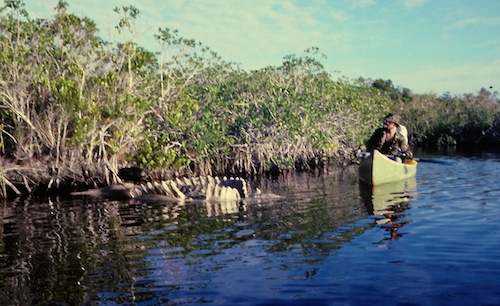
Let’s Get Serious
Eventually Ken or I got the idea we should make a through trip. We made preparations, and got some victims to participate (Susan, Ken’s brother Jay, Dave, and Renee), and drove to south Florida.
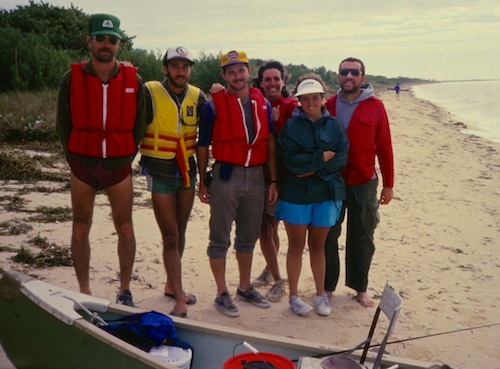
We launched our canoes at the SR 41 bridge over the Turner River. Our destination, over 100 miles away, was Flamingo. There were thirteen days between launch and load up to go home.
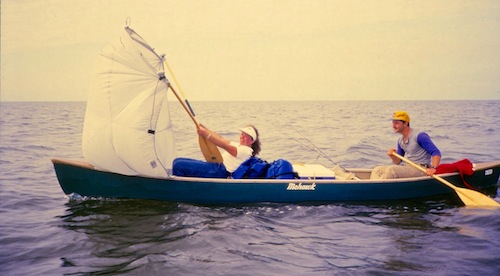
We spent Christmas at Lostman’s Key. We exchanged small gifts such as hand cream and chocolate bars. We had fried mullet for dinner.
We spent New Year’s Eve at Middle Cape. Other people were camped there, too.
A passing fisherman told us the tide that night was to be the highest in 10 years. He also told us there was a big storm on the way. We thanked him, and battened down our gear.
Rain spit at us as we made and ate dinner, watching the clouds come in.
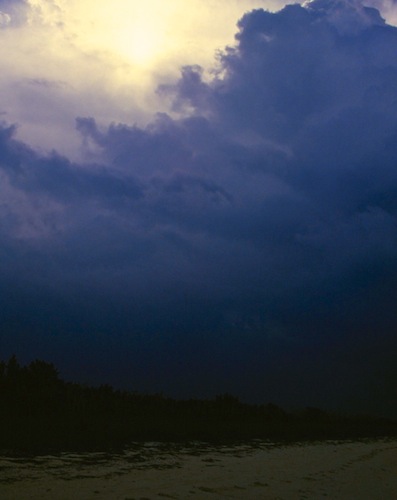
Rain on the tent fly makes a soothing sound, makes it easy to fall asleep.
Waves under your tent in the dark do not sooth at all.
Sue and I jumped out into the water, into the storm. Wind, rain, lightning, and the sounds of people screaming assaulted us as we picked up the tent, looking for a dry patch of ground. Ken showed up and tried to get us to hike way back into the bushes. I didn’t think that was necessary. We found a dry patch, put the tent down, and jumped in. After drying off and laughing a little bit we were soon back asleep.
Shortly, we were awake again. The water had risen and was again under the tent.
The storm was hitting a crescendo now. The screaming was loud. Everyone out there was flooded. Lightning flashed and crashed almost simultaneously, right on top of us. Rain pelted.
Remarkably, Ken was back with the directions to a still-dry patch. Not wanting to repeat the earlier stupidity, we followed him this time.
Someone was singing Auld Lang Syne. It was New Year’s, the most memorable I’ve ever had.
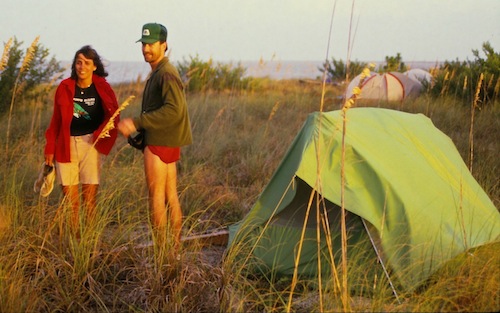
Fishing and Food, Food and Fishing
On everglades trips, food and fishing twined around each other like a strangler fig on a cabbage palm.
Ken said to me on one trip, “This is a great trip. No shouldabroughts.”
I didn’t know what he was talking about. “You know,” he said. “I should have brought this, I should have brought that. We have everything.”
I did not know how to fish in Florida on the first trip, the one where we ate crevalle jacks. They’re edible but not very good. We ate a redfish, the only one we caught. That was very good.
My fishing knowledge grew by leaps. On subsequent trips we planned on eating fish and crabs for half of our meals. We ate seatrout, redfish, mullet, snook, sheepshead, black drum, mangrove snappers, blacktip sharks, oysters, blue crabs, and stone crab claws. I’d bring a cast net. We’d ask passing fishermen if they had any shrimp to sell (we often got beer that way, too). We would find bait crabs in oysters, or in the mangroves when it got cold. We would always get some fish.
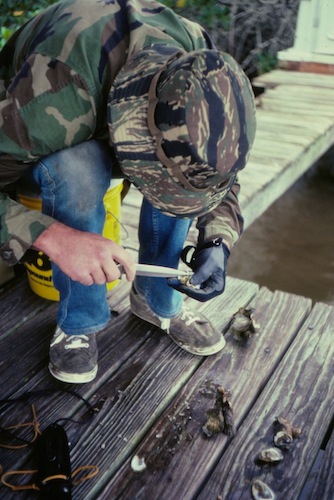
—–
On my first encounter with a live blue crab it gave a painful lesson that they don’t like being trifled with. Tim and I were fishing in Joe River when a large blue crab swam by. I saw meat for my jig, on the hoof, as it were.
I scooped it up with a landing net, and deposited it on the floor of the canoe.
To this day I wonder why I disregarded those very mean looking claws. I casually went to pick up the crab, with the intent of putting one of its legs on my jig. The crab pinched the meaty part of the heel of my hand and squeezed surprisingly and quite painfully hard.
I shook my hand, trying to fling it off. It wouldn’t let go.
Getting frantic, I put the crab on the deck of the canoe. With my free hand I grabbed a machete and smashed the handle down on the crab’s carapace, effectively killing it. It let go.
Blood oozed from the pinch wound on my hand, which swelled up and became discolored. Paddling was painful for a couple of days after that.
I did finally get the crab leg on my jig, and was rewarded with a cobia about 12 inches long.
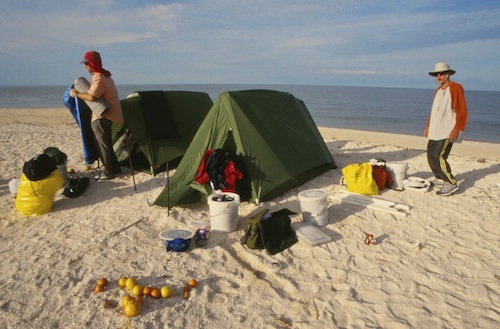
—–
On the through trip we were running out of fuel for the stove and breadcrumbs for frying the fish by the time we reached Cape Sable. There were lots of roe mullet in the Mid-Cape Canal. Susan and I took the cast net and paddled up there.
There is a big difference between having a net and knowing how to throw it. Even if you know how, throwing a net from a canoe is difficult.
The canal had so many mullet that in spite of my inept attempts with the net we caught 12 or 15. They were nice big ones, too, a couple of pounds each.
I filleted and skinned them all. There was more than we could eat so I went from campsite to campsite, looking to barter for more gas and breadcrumbs. As it turned out I had to settle for cornmeal. The person I traded with for the cornmeal was the late Rick Farren. He was a field editor for Florida Sportsman magazine at the time. Because of that chance meeting we became friends, and I started a career in writing. We usually got to see each other at least once a year after that. Sadly, he died much too young.
On Cape Sable I was able to use mullet fillets as a medium of exchange, the only time I’ve ever been able to do that.
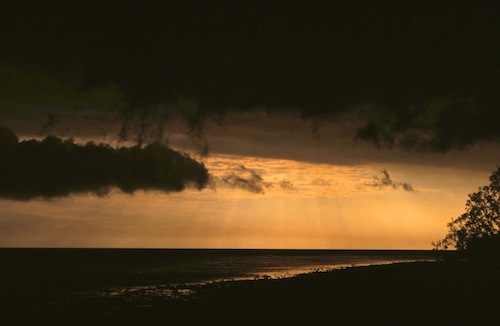
—–
We would drag lures behind the boats as we paddled, and caught lots of fish that way. My favorite lure was the Rebel swimming minnow. It would float to the top if we stopped paddling, instead of sinking and hanging on the bottom, and it worked pretty well. Fish we usually caught were jacks, ladyfish, seatrout, and lizardfish.
We got lizardfish for the first time on the trip with Tim and Ward. Ward got this ugly little fish, mottled green with a big head, huge mouth, and rows of little needles for teeth. I didn’t know what it was. Ward called it a “big mouth.” That’s what it was for the rest of the trip until someone finally told us what it was.
On the through trip Susan and I were the lead boat at one point. She was dragging a line, and her rod started to bend. “You have a fish,” I said. She started to pick up the rod but before she could turn around the rod bent over double and there was a tremendous splash behind the boat. Her line snapped and went limp. A large tarpon had taken her lure, jumped about eight feet in the air, and broken her line before she could begin to respond. Neither of us saw it, but everyone in the following boats did.
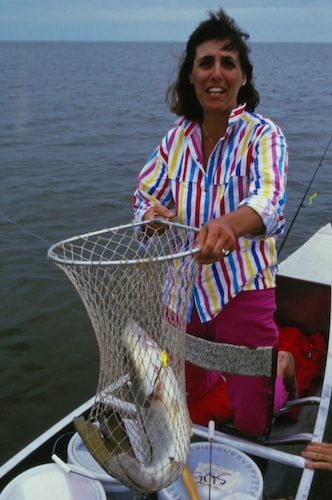
—–
We would scrounge other wild foods while we were there, too. We would eat the prickly pears, very carefully. They’re not very good, but they are juicy. And the juice had the advantage of staining your hands and mouth purple. Hey, you take entertainment where you find it, especially out there.
There are coconut palms on Cape Sable. I’m not a climber, but Ward was. He climbed up a palm tree and cut down a bunch of coconuts.
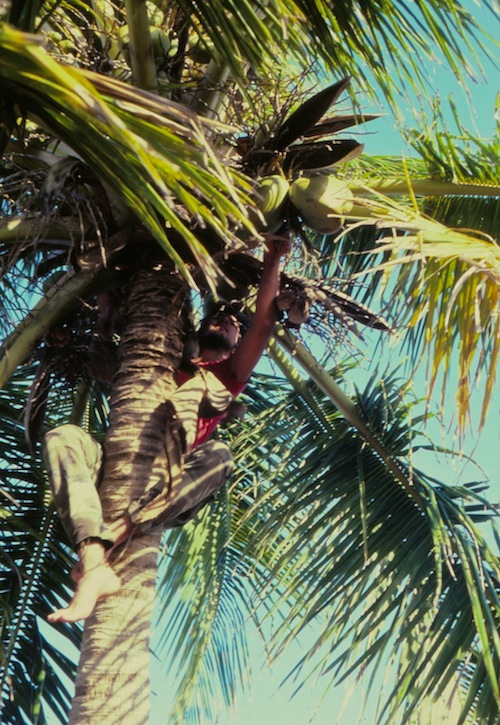
We were young and stupid. If he had fallen we would have had a very large problem.
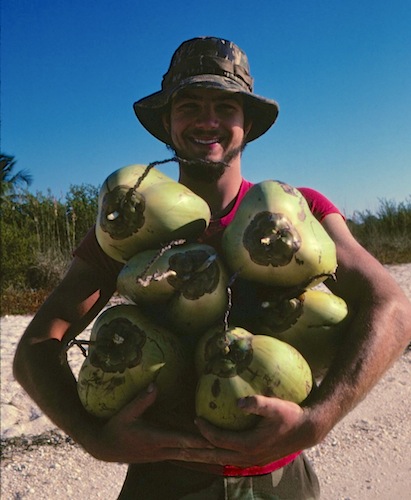
We used a machete to cut off the end, then we drank the juice. Once it was empty we cut a little scooper from the hull, split the nut, and scraped out and ate the insides. They are really good.
Nightfall
In the everglades, you feel the sun wheel through the sky during the day, then watch the stars and moon wheel through the sky for much of the night. We sleep on the ground, often less than comfortably. The night sky makes up for the lack of comfort.
We had campfires almost every evening. Campfires offer one of the most pleasurable aspects of the trip- the warm, mesmerizing dance of the flames below, the stars wheeling overhead. Conversation. Television has nothing with which to compare.

We would often fish after dark, catching snook, catfish, sharks, and too often getting spooled by monster fishes that never stopped.
I took six of my high school students down for a field trip over spring break one year. I told the school board we were going to study the ecology of the national park. We did, using fishing rods as our primary tools.
On our last day at Cape Sable some of us went fishing. Some kids stayed in camp. When we got back to camp it looked like a tornado had gone through.
I jumped out of my canoe and started haranguing the kids to clean up. We had an early start tomorrow, yadayadayada, etc. After cleanup the rest of the evening went of normally.
About 3 AM I got up to pee, and to watch Halley’s Comet, which was visible from earth at the time. While doing so I noticed we only had three canoes when we should have had four. “One of those dumb kids didn’t pull their canoe up,” I thought. Closer inspection revealed I was the dumb kid. Mine was the missing vessel.
When I had jumped out of my canoe, so concerned about the messy camp, I never pulled it up above the high tide line. During the night the tide had risen and the boat floated away.
In the morning we had to pack eight of us and all our gear into three small canoes for the 15 mile paddle back to Flamingo. Thankfully it was not windy.
I reported the loss to the rangers. Several hours later one drove up to our campsite and told me someone had found my canoe and taken it to Islamorada. He gave me an address. I took the youngster whose stuff was in the boat when it floated away and we drove over and got it. Everything in it was lost, but we did get the boat back.
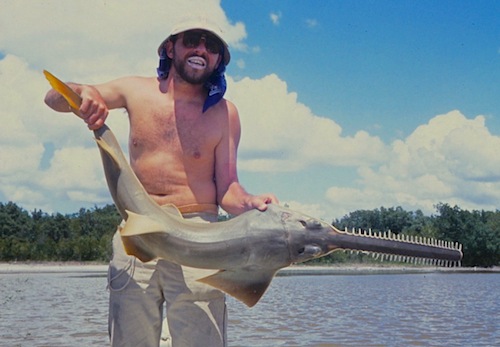
At low tide at Graveyard Creek the water is a half-mile away from the campsite. Thick, black, gloopy mud covers the intervening distance.
Tim, Ward, and I left in the middle of the night in order to catch high water. Our destination was Cape Sable.
We paddled south by starlight. Orion was the dominant constellation. It slowly wheeled further west, got lower and lower.
As the third I paddled solo. I couldn’t keep up with my two friends, and learned to keep all the food that didn’t need to be cooked with me. They would stop and wait for me whenever they got hungry.
They didn’t get hungry until after daylight. I was alone on the water, the darkness my only companion. The barely visible mangroves to my left and the dog star ahead were my guides.
The air was still and damp, fragrant with wet earth odors. Mullet splashed. It was spooky out there in the dark. I heard big splashes, dolphins blowing, unidentified floppings, wild things screaming along the shore. I knew there were big tarpon and big sharks around me.
The annoying buzzing around my ears stopped after a spray can hissed.
The paddle steadily stroked. The shoreline slowly changed. Faint pink light came to the sky.
Another sunrise came to the everglades. I got to watch it in all its glory.
Kids Arrive
I brought son Maxx and his friend Mike to Cape Sable one year, using a (gulp!) skiff instead of a canoe. When we got up the first morning the tide was low, still falling, and the boat was way up on the beach. I hadn’t anchored it out far enough. We weren’t leaving for hours, until the water returned.
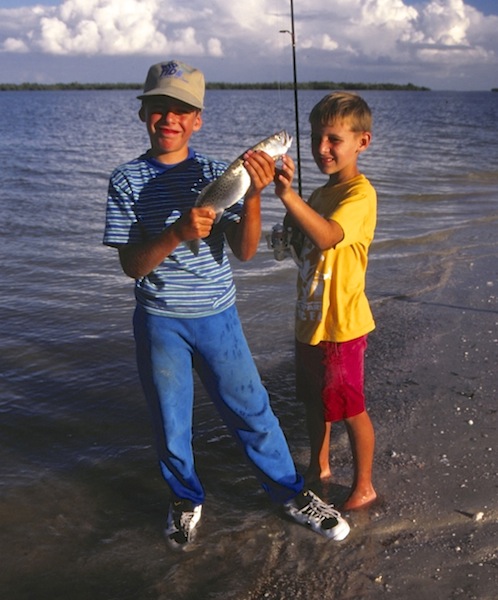
I grabbed a fishing rod and went walking north up the beach.
No fish were found. But a mile or so from camp was the box (no lid) of a 120 quart Igloo cooler, washed up as flotsam. While looking at it I thought it might make a superior livewell for night beach fishing. I dragged it back to camp.
“What’s that for?” Maxx wanted to know.
“We can fill it with water and put mullet in it,” I told him.
“What will we do with it when we leave?”
“Well, you can look at it one of two ways, son,” I said. “We found it here, we’re leaving it here. Or, we took possession of it and now it’s our responsibility to take it to the trash. We’ll see how much space we have when we leave.”
That evening we poured 10 gallons of water into the box, put a few dozen mullet in it, and set the lines. Things went perfectly until the sun set.
An army of raccoons arrived, a murderous gleam in their beady little eyes.
Maxx, Mike, and I armed ourselves with firewood clubs to guard the mullet.
The raccoons completely outclassed us. They would dart in and grab mullet at will. My brilliant idea quickly turned into a failed experiment. We watched from the sidelines as the ‘coons polished off the last of the bait fish.
The box sat lonely and unloved for a couple of days.
We were sitting around the campfire our last night out when the light bulb went off in my head. “Maxx, I just had another idea of what to do with the cooler.”
“What’s that?” he asked.
“Put in on the fire.”
“That won’t burn,” he said.
I laughed a long time. “Try it.”
Within moments we had to move our seats 100 feet away. The heat and ferocity of the flames surprised even me, as thick black smoke billowed into the inky night sky.
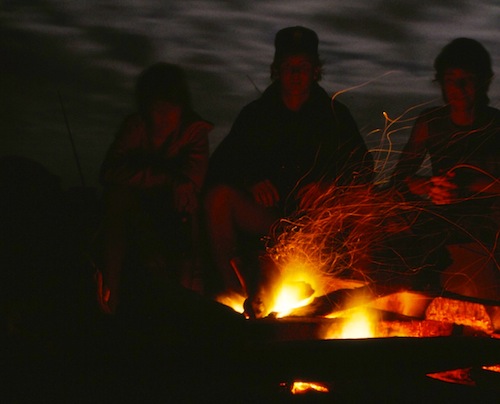
—–
In late 1987 Susan was gravid with Maxx. We wanted a less rigorous everglades trip. I bought a small outboard and with a bracket attached it to the Old Town. Ken did the same, and we all went, with his brother Jay the fourth.
If while you paddle the canoe tips, you can easily lean on the paddle and keep your balance. If, while operating a canoe with a small outboard motor the canoe tips, you’re in the water real fast. It was cold, waist deep, and Susan and I were in it. The canoe was upside down. I was concerned for my wife. Ken and Jay effected a rescue.
Apparently there was no harm.
Susan gave birth to a healthy, seven pound Maxx in July 1988, a joyous occasion. When Maxx was born there was an overhand knot in his umbilical cord. The delivering doctor had never seen one before. Pulled tight it would have killed him.
Susan’s eyes met mine and there was a mutual flash of recognition- “That happened when the canoe flipped!”
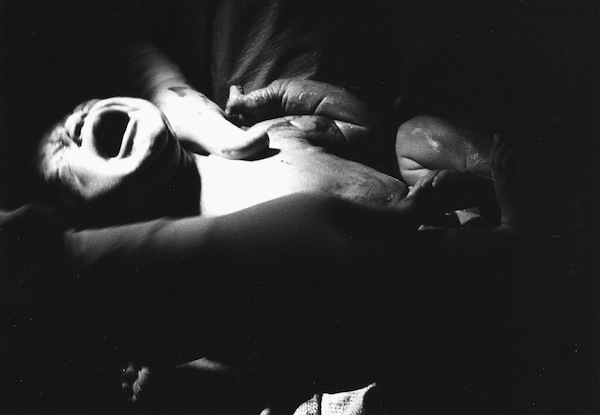
—–
Having children changed the nature of my trips to the everglades. Susan sensibly informed me she was not an official babysitter. I could still go to the everglades all I wanted. The children had to come with me.
Using the johnboat, I took Maxx on a three day trip to Cape Sable when he was two. He was well behaved, a joy to have there. We did have a diaper burning in the campfire every night. I stayed upwind.
On that trip I took a picture of him that was a cover on The Fisherman.
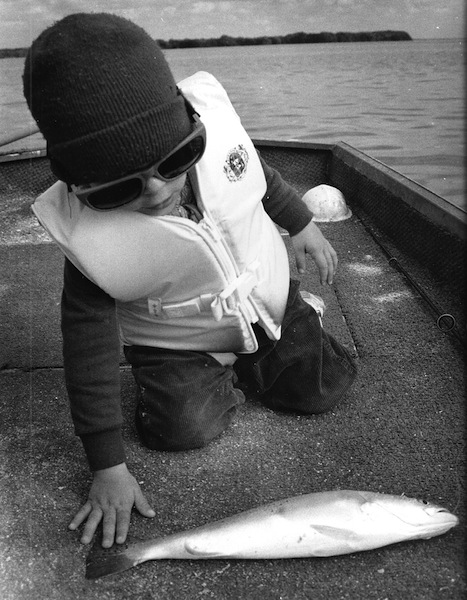
My boys got their everglades exposure a day here, three days there, always by internal combustion, until Maxx was 12. Then, with Ken, Mark, Mark’s 11 year old Jason, and Maxx and Alex, we took three canoes on a nine day loop trip starting at the Hell’s Bay Canoe Trail.
Things had changed. There were motorboats everywhere now. It seemed there were a lot fewer fish, too.
At the Joe River chickee Ken the merman had the kids swimming. It was all fun until Jason sliced his leg open on an oyster.
It was a real cut, eight or ten inches long, quite deep. I dug out the first aid kit.
Ken cleaned the wound with antiseptic, then taped it with butterflies. We applied pressure until it stopped bleeding, then bandaged it up. Jason was told to keep it dry.
Jason has a scar on his leg today (I’m told), but the cut healed without incident, fortunately for all of us.
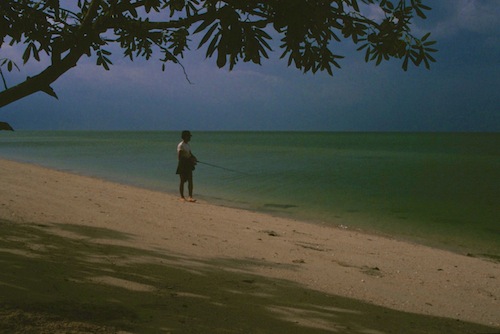
—–
I lost my enthusiasm for long everglades canoe trips after that last one. If I want to deal with motorboats I can stay around home.
The appeal of the everglades, for me at least, was to get as far away from other humanity as possible. I don’t mean to be selfish, but I want it all for myself.
With the advent of the flats skiff onslaught (I have owned several and currently own one) that appeal is gone. There are as many skiffs around Flamingo as there are in Mosquito Lagoon.
I still visit the everglades and fish in the no motor area. Alex got a fly rod slam on our last visit, tarpon, snook, redfish.
But the everglades backcountry just ain’t back enough for me anymore…
Technical Information-
Most of the images displayed here were captured on film, either Kodachrome 64 or Fujichrome 100. Most of them were shot with a Canon AE-1. A few were shot with a point and shoot. One (the birds) was shot with digital media.
I used a Canoscan 9000F to scan the slides. I thought it worked well. Editing has been minimal, with Photoshop Elements, iPhoto, or Preview used.
